Critical Analysis: Capital Structures & Profitability - Pharma ASX
VerifiedAdded on 2023/06/10
|103
|27915
|253
Thesis and Dissertation
AI Summary
This thesis critically examines the capital structures and profitability of pharmaceutical companies listed on the Australian Stock Exchange (ASX). The study focuses on the relationship between debt and equity, analyzing how capital structure influences a company's financial performance. It incorporates a review of existing literature on capital structure theory and market imperfections, employing both descriptive and inferential statistical methods to analyze secondary data from selected pharmaceutical, biotechnology, and life science companies. The research investigates factors affecting capital structure, including the impact of financial market conditions and strategic decisions made by company management. The findings contribute to understanding the strategic role of capital structure in enhancing organizational value within the healthcare sector. Desklib provides access to similar research papers and study resources for students.
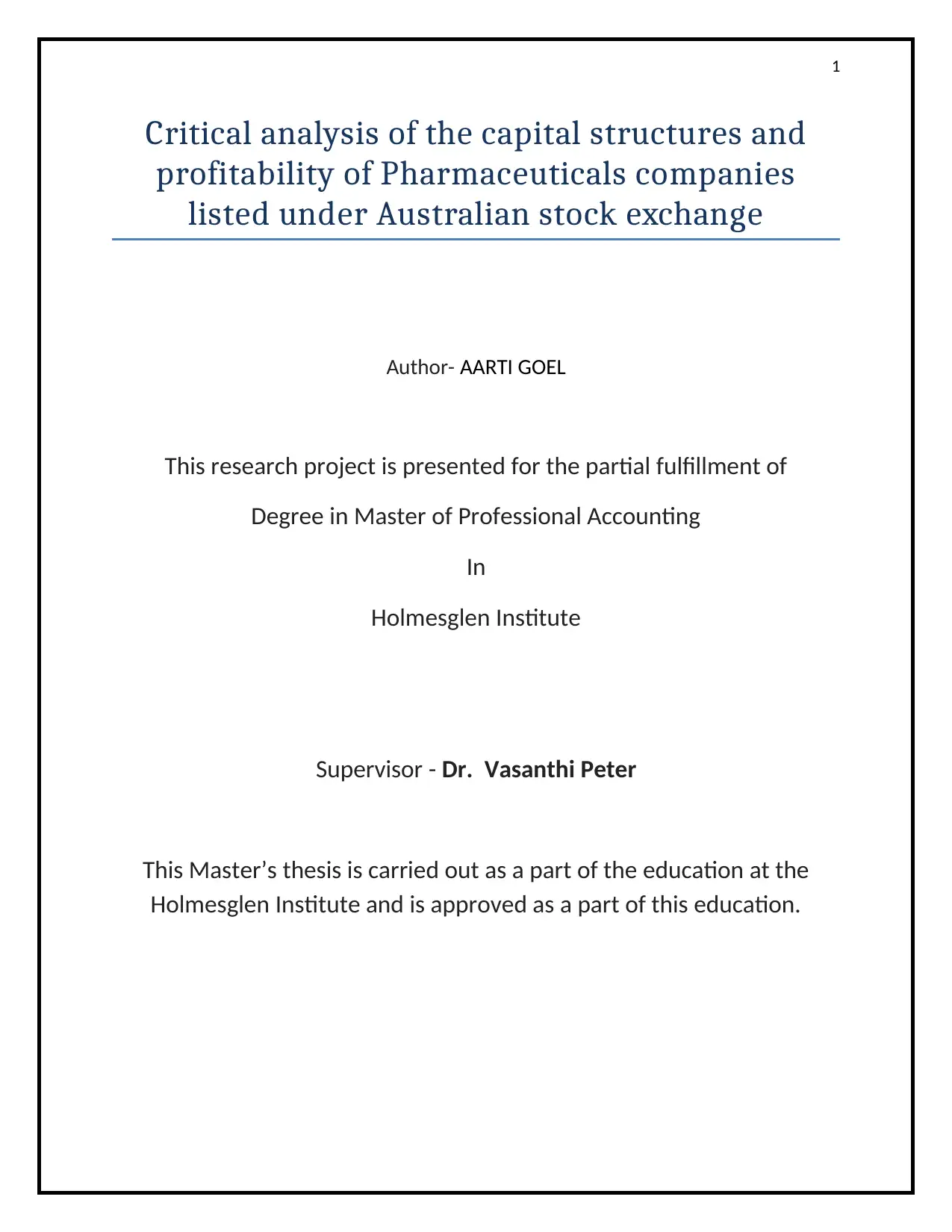
1
Critical analysis of the capital structures and
profitability of Pharmaceuticals companies
listed under Australian stock exchange
Author- AARTI GOEL
This research project is presented for the partial fulfillment of
Degree in Master of Professional Accounting
In
Holmesglen Institute
Supervisor - Dr. Vasanthi Peter
This Master’s thesis is carried out as a part of the education at the
Holmesglen Institute and is approved as a part of this education.
Critical analysis of the capital structures and
profitability of Pharmaceuticals companies
listed under Australian stock exchange
Author- AARTI GOEL
This research project is presented for the partial fulfillment of
Degree in Master of Professional Accounting
In
Holmesglen Institute
Supervisor - Dr. Vasanthi Peter
This Master’s thesis is carried out as a part of the education at the
Holmesglen Institute and is approved as a part of this education.
Paraphrase This Document
Need a fresh take? Get an instant paraphrase of this document with our AI Paraphraser
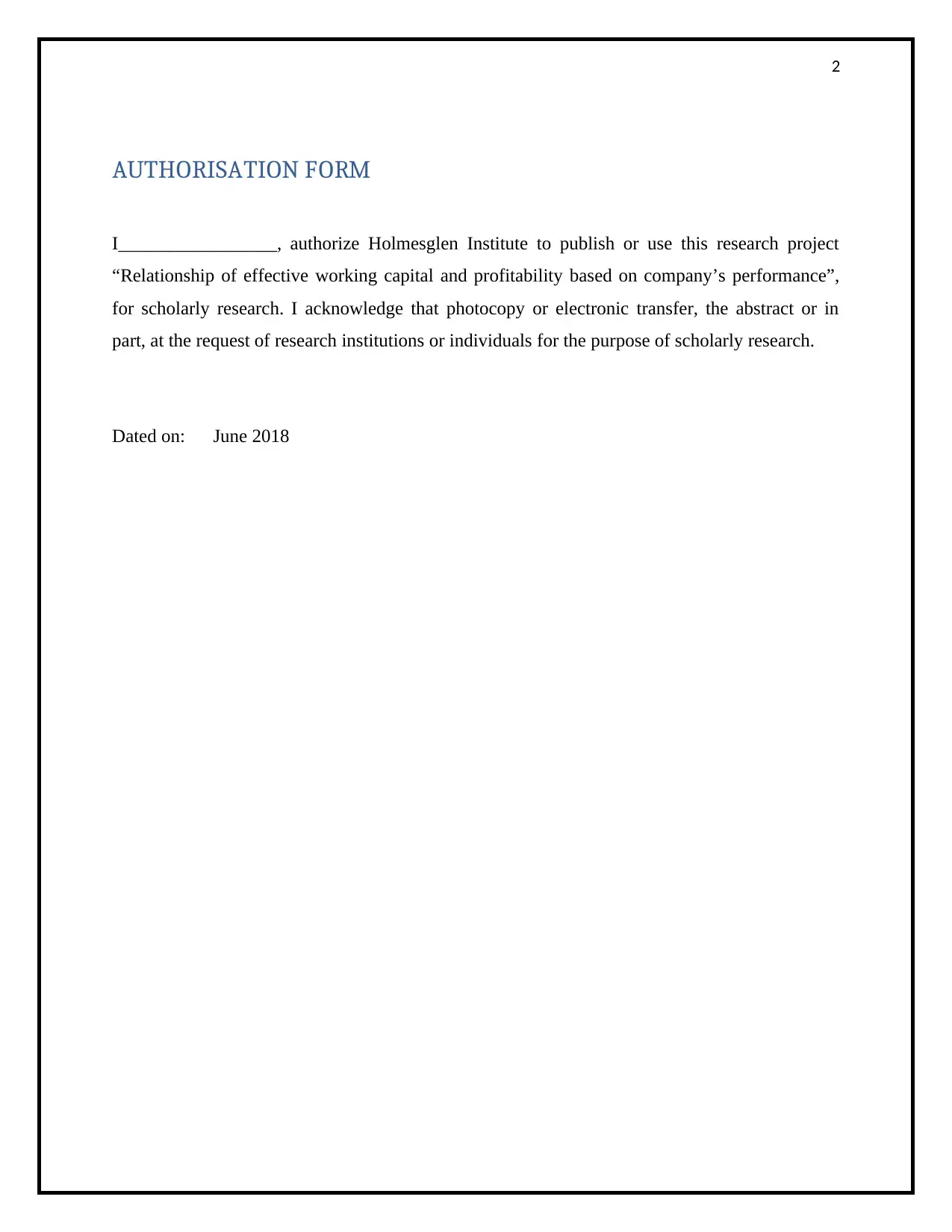
2
AUTHORISATION FORM
I_________________, authorize Holmesglen Institute to publish or use this research project
“Relationship of effective working capital and profitability based on company’s performance”,
for scholarly research. I acknowledge that photocopy or electronic transfer, the abstract or in
part, at the request of research institutions or individuals for the purpose of scholarly research.
Dated on: June 2018
AUTHORISATION FORM
I_________________, authorize Holmesglen Institute to publish or use this research project
“Relationship of effective working capital and profitability based on company’s performance”,
for scholarly research. I acknowledge that photocopy or electronic transfer, the abstract or in
part, at the request of research institutions or individuals for the purpose of scholarly research.
Dated on: June 2018
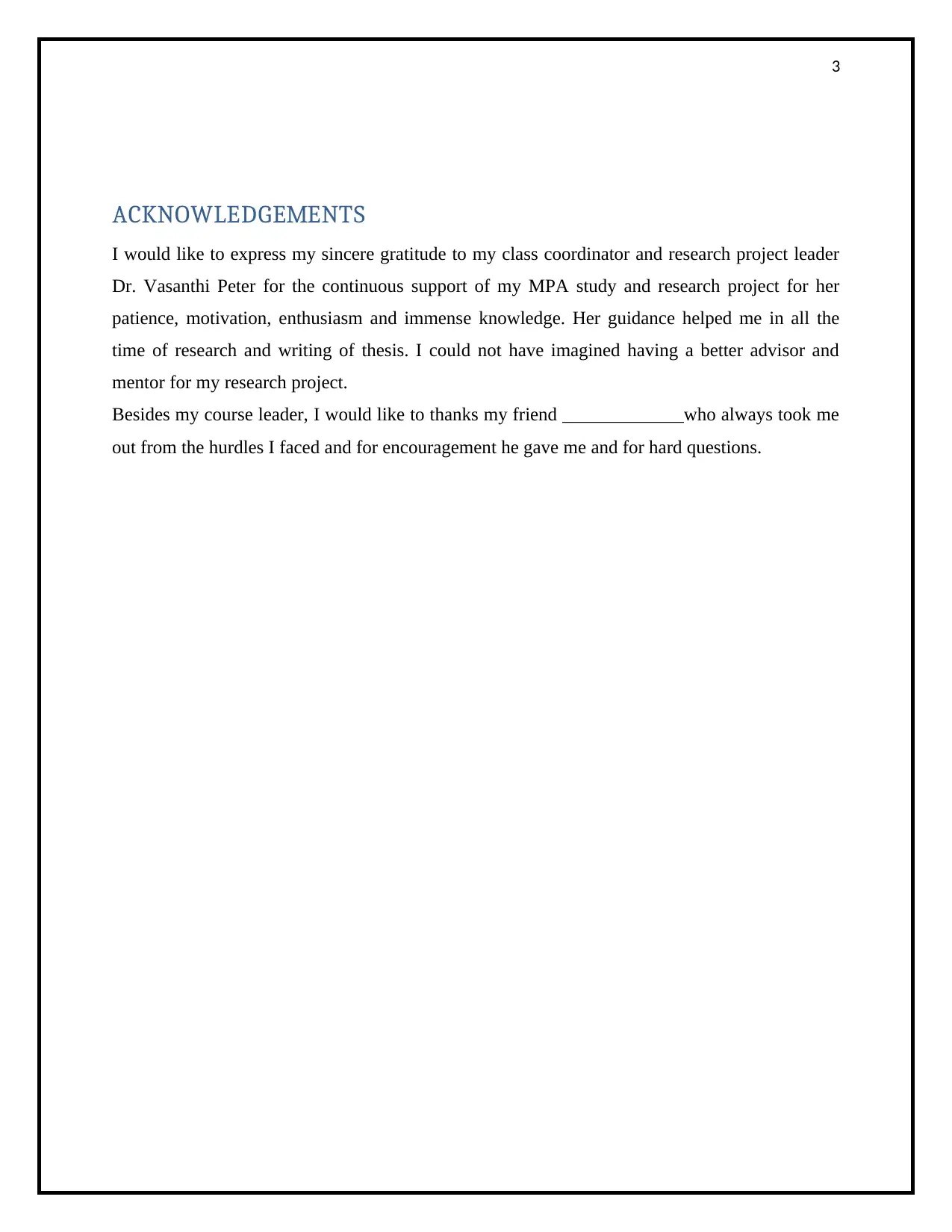
3
ACKNOWLEDGEMENTS
I would like to express my sincere gratitude to my class coordinator and research project leader
Dr. Vasanthi Peter for the continuous support of my MPA study and research project for her
patience, motivation, enthusiasm and immense knowledge. Her guidance helped me in all the
time of research and writing of thesis. I could not have imagined having a better advisor and
mentor for my research project.
Besides my course leader, I would like to thanks my friend _____________who always took me
out from the hurdles I faced and for encouragement he gave me and for hard questions.
ACKNOWLEDGEMENTS
I would like to express my sincere gratitude to my class coordinator and research project leader
Dr. Vasanthi Peter for the continuous support of my MPA study and research project for her
patience, motivation, enthusiasm and immense knowledge. Her guidance helped me in all the
time of research and writing of thesis. I could not have imagined having a better advisor and
mentor for my research project.
Besides my course leader, I would like to thanks my friend _____________who always took me
out from the hurdles I faced and for encouragement he gave me and for hard questions.
⊘ This is a preview!⊘
Do you want full access?
Subscribe today to unlock all pages.

Trusted by 1+ million students worldwide
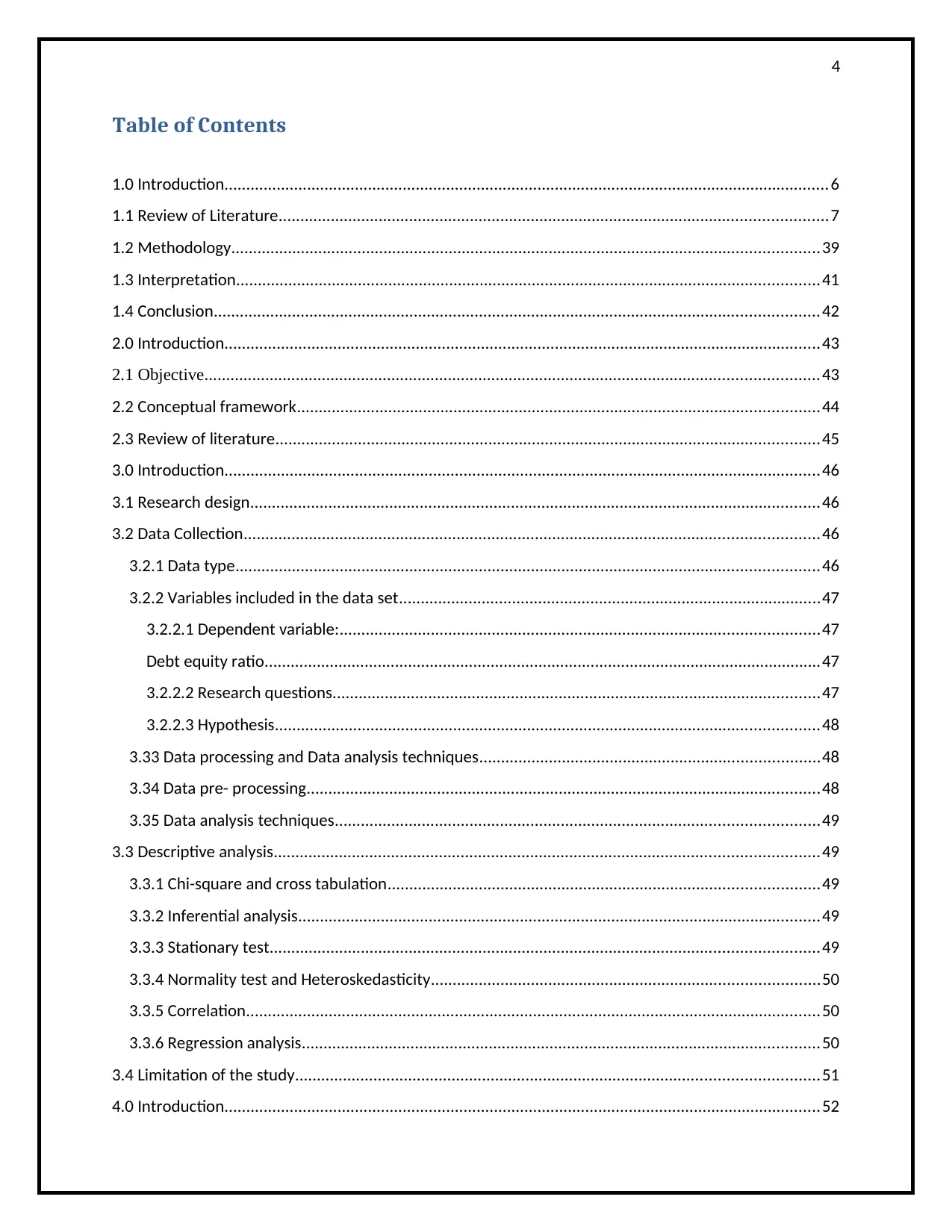
4
Table of Contents
1.0 Introduction...........................................................................................................................................6
1.1 Review of Literature..............................................................................................................................7
1.2 Methodology.......................................................................................................................................39
1.3 Interpretation......................................................................................................................................41
1.4 Conclusion...........................................................................................................................................42
2.0 Introduction.........................................................................................................................................43
2.1 Objective.............................................................................................................................................43
2.2 Conceptual framework........................................................................................................................44
2.3 Review of literature.............................................................................................................................45
3.0 Introduction.........................................................................................................................................46
3.1 Research design...................................................................................................................................46
3.2 Data Collection....................................................................................................................................46
3.2.1 Data type......................................................................................................................................46
3.2.2 Variables included in the data set.................................................................................................47
3.2.2.1 Dependent variable:..............................................................................................................47
Debt equity ratio................................................................................................................................47
3.2.2.2 Research questions................................................................................................................47
3.2.2.3 Hypothesis.............................................................................................................................48
3.33 Data processing and Data analysis techniques..............................................................................48
3.34 Data pre- processing......................................................................................................................48
3.35 Data analysis techniques...............................................................................................................49
3.3 Descriptive analysis.............................................................................................................................49
3.3.1 Chi-square and cross tabulation...................................................................................................49
3.3.2 Inferential analysis........................................................................................................................49
3.3.3 Stationary test..............................................................................................................................49
3.3.4 Normality test and Heteroskedasticity.........................................................................................50
3.3.5 Correlation....................................................................................................................................50
3.3.6 Regression analysis.......................................................................................................................50
3.4 Limitation of the study........................................................................................................................51
4.0 Introduction.........................................................................................................................................52
Table of Contents
1.0 Introduction...........................................................................................................................................6
1.1 Review of Literature..............................................................................................................................7
1.2 Methodology.......................................................................................................................................39
1.3 Interpretation......................................................................................................................................41
1.4 Conclusion...........................................................................................................................................42
2.0 Introduction.........................................................................................................................................43
2.1 Objective.............................................................................................................................................43
2.2 Conceptual framework........................................................................................................................44
2.3 Review of literature.............................................................................................................................45
3.0 Introduction.........................................................................................................................................46
3.1 Research design...................................................................................................................................46
3.2 Data Collection....................................................................................................................................46
3.2.1 Data type......................................................................................................................................46
3.2.2 Variables included in the data set.................................................................................................47
3.2.2.1 Dependent variable:..............................................................................................................47
Debt equity ratio................................................................................................................................47
3.2.2.2 Research questions................................................................................................................47
3.2.2.3 Hypothesis.............................................................................................................................48
3.33 Data processing and Data analysis techniques..............................................................................48
3.34 Data pre- processing......................................................................................................................48
3.35 Data analysis techniques...............................................................................................................49
3.3 Descriptive analysis.............................................................................................................................49
3.3.1 Chi-square and cross tabulation...................................................................................................49
3.3.2 Inferential analysis........................................................................................................................49
3.3.3 Stationary test..............................................................................................................................49
3.3.4 Normality test and Heteroskedasticity.........................................................................................50
3.3.5 Correlation....................................................................................................................................50
3.3.6 Regression analysis.......................................................................................................................50
3.4 Limitation of the study........................................................................................................................51
4.0 Introduction.........................................................................................................................................52
Paraphrase This Document
Need a fresh take? Get an instant paraphrase of this document with our AI Paraphraser
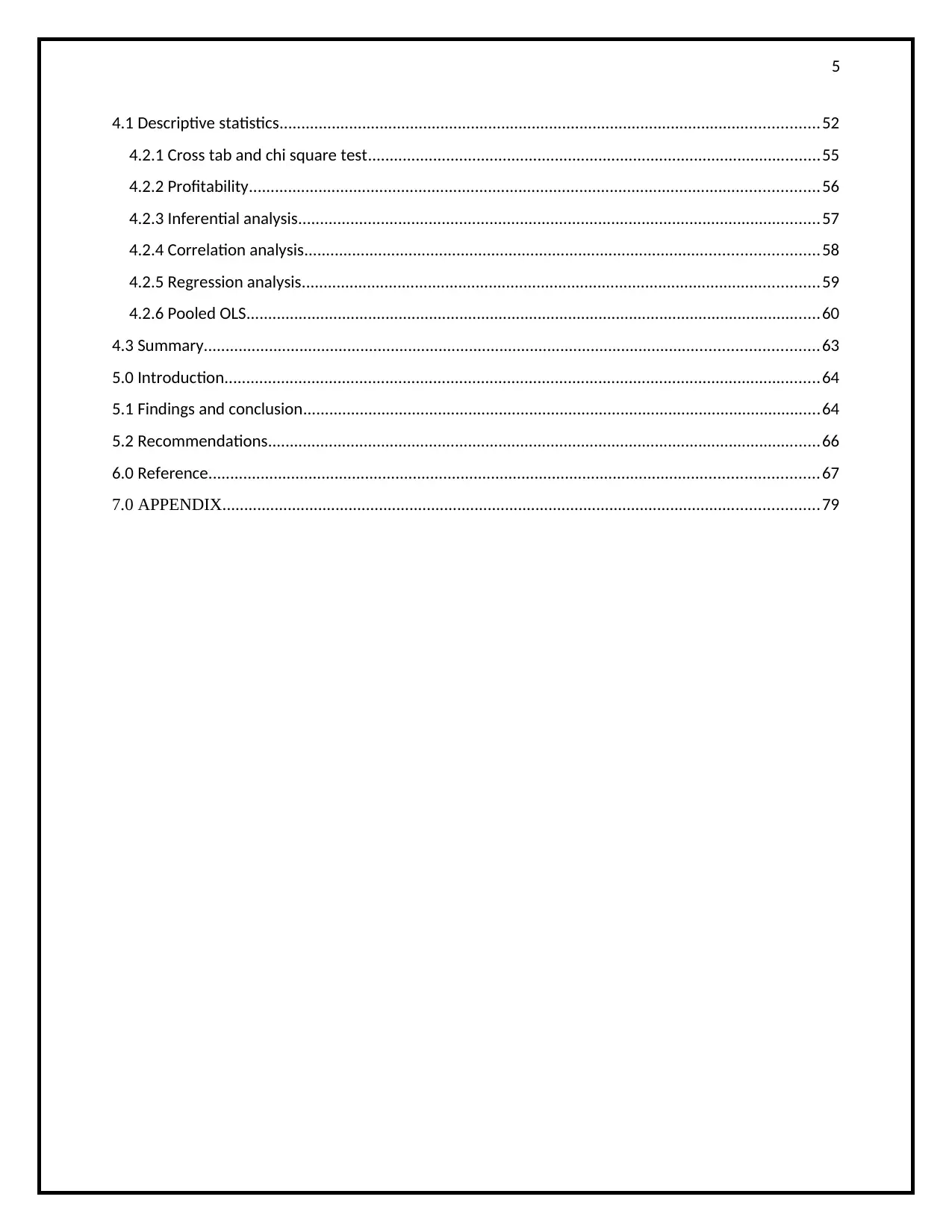
5
4.1 Descriptive statistics............................................................................................................................52
4.2.1 Cross tab and chi square test........................................................................................................55
4.2.2 Profitability...................................................................................................................................56
4.2.3 Inferential analysis........................................................................................................................57
4.2.4 Correlation analysis......................................................................................................................58
4.2.5 Regression analysis.......................................................................................................................59
4.2.6 Pooled OLS....................................................................................................................................60
4.3 Summary.............................................................................................................................................63
5.0 Introduction.........................................................................................................................................64
5.1 Findings and conclusion.......................................................................................................................64
5.2 Recommendations...............................................................................................................................66
6.0 Reference............................................................................................................................................67
7.0 APPENDIX.........................................................................................................................................79
4.1 Descriptive statistics............................................................................................................................52
4.2.1 Cross tab and chi square test........................................................................................................55
4.2.2 Profitability...................................................................................................................................56
4.2.3 Inferential analysis........................................................................................................................57
4.2.4 Correlation analysis......................................................................................................................58
4.2.5 Regression analysis.......................................................................................................................59
4.2.6 Pooled OLS....................................................................................................................................60
4.3 Summary.............................................................................................................................................63
5.0 Introduction.........................................................................................................................................64
5.1 Findings and conclusion.......................................................................................................................64
5.2 Recommendations...............................................................................................................................66
6.0 Reference............................................................................................................................................67
7.0 APPENDIX.........................................................................................................................................79
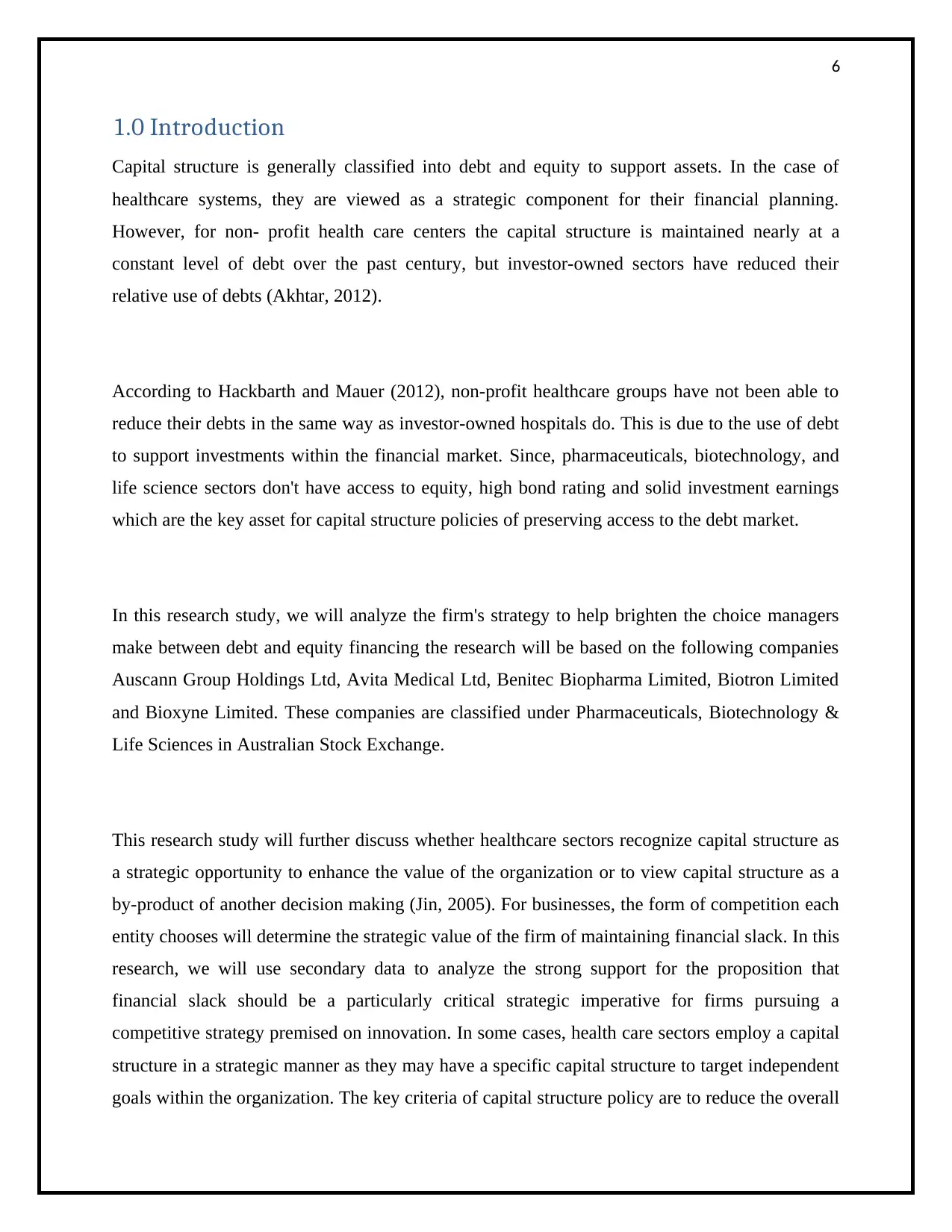
6
1.0 Introduction
Capital structure is generally classified into debt and equity to support assets. In the case of
healthcare systems, they are viewed as a strategic component for their financial planning.
However, for non- profit health care centers the capital structure is maintained nearly at a
constant level of debt over the past century, but investor-owned sectors have reduced their
relative use of debts (Akhtar, 2012).
According to Hackbarth and Mauer (2012), non-profit healthcare groups have not been able to
reduce their debts in the same way as investor-owned hospitals do. This is due to the use of debt
to support investments within the financial market. Since, pharmaceuticals, biotechnology, and
life science sectors don't have access to equity, high bond rating and solid investment earnings
which are the key asset for capital structure policies of preserving access to the debt market.
In this research study, we will analyze the firm's strategy to help brighten the choice managers
make between debt and equity financing the research will be based on the following companies
Auscann Group Holdings Ltd, Avita Medical Ltd, Benitec Biopharma Limited, Biotron Limited
and Bioxyne Limited. These companies are classified under Pharmaceuticals, Biotechnology &
Life Sciences in Australian Stock Exchange.
This research study will further discuss whether healthcare sectors recognize capital structure as
a strategic opportunity to enhance the value of the organization or to view capital structure as a
by-product of another decision making (Jin, 2005). For businesses, the form of competition each
entity chooses will determine the strategic value of the firm of maintaining financial slack. In this
research, we will use secondary data to analyze the strong support for the proposition that
financial slack should be a particularly critical strategic imperative for firms pursuing a
competitive strategy premised on innovation. In some cases, health care sectors employ a capital
structure in a strategic manner as they may have a specific capital structure to target independent
goals within the organization. The key criteria of capital structure policy are to reduce the overall
1.0 Introduction
Capital structure is generally classified into debt and equity to support assets. In the case of
healthcare systems, they are viewed as a strategic component for their financial planning.
However, for non- profit health care centers the capital structure is maintained nearly at a
constant level of debt over the past century, but investor-owned sectors have reduced their
relative use of debts (Akhtar, 2012).
According to Hackbarth and Mauer (2012), non-profit healthcare groups have not been able to
reduce their debts in the same way as investor-owned hospitals do. This is due to the use of debt
to support investments within the financial market. Since, pharmaceuticals, biotechnology, and
life science sectors don't have access to equity, high bond rating and solid investment earnings
which are the key asset for capital structure policies of preserving access to the debt market.
In this research study, we will analyze the firm's strategy to help brighten the choice managers
make between debt and equity financing the research will be based on the following companies
Auscann Group Holdings Ltd, Avita Medical Ltd, Benitec Biopharma Limited, Biotron Limited
and Bioxyne Limited. These companies are classified under Pharmaceuticals, Biotechnology &
Life Sciences in Australian Stock Exchange.
This research study will further discuss whether healthcare sectors recognize capital structure as
a strategic opportunity to enhance the value of the organization or to view capital structure as a
by-product of another decision making (Jin, 2005). For businesses, the form of competition each
entity chooses will determine the strategic value of the firm of maintaining financial slack. In this
research, we will use secondary data to analyze the strong support for the proposition that
financial slack should be a particularly critical strategic imperative for firms pursuing a
competitive strategy premised on innovation. In some cases, health care sectors employ a capital
structure in a strategic manner as they may have a specific capital structure to target independent
goals within the organization. The key criteria of capital structure policy are to reduce the overall
⊘ This is a preview!⊘
Do you want full access?
Subscribe today to unlock all pages.

Trusted by 1+ million students worldwide
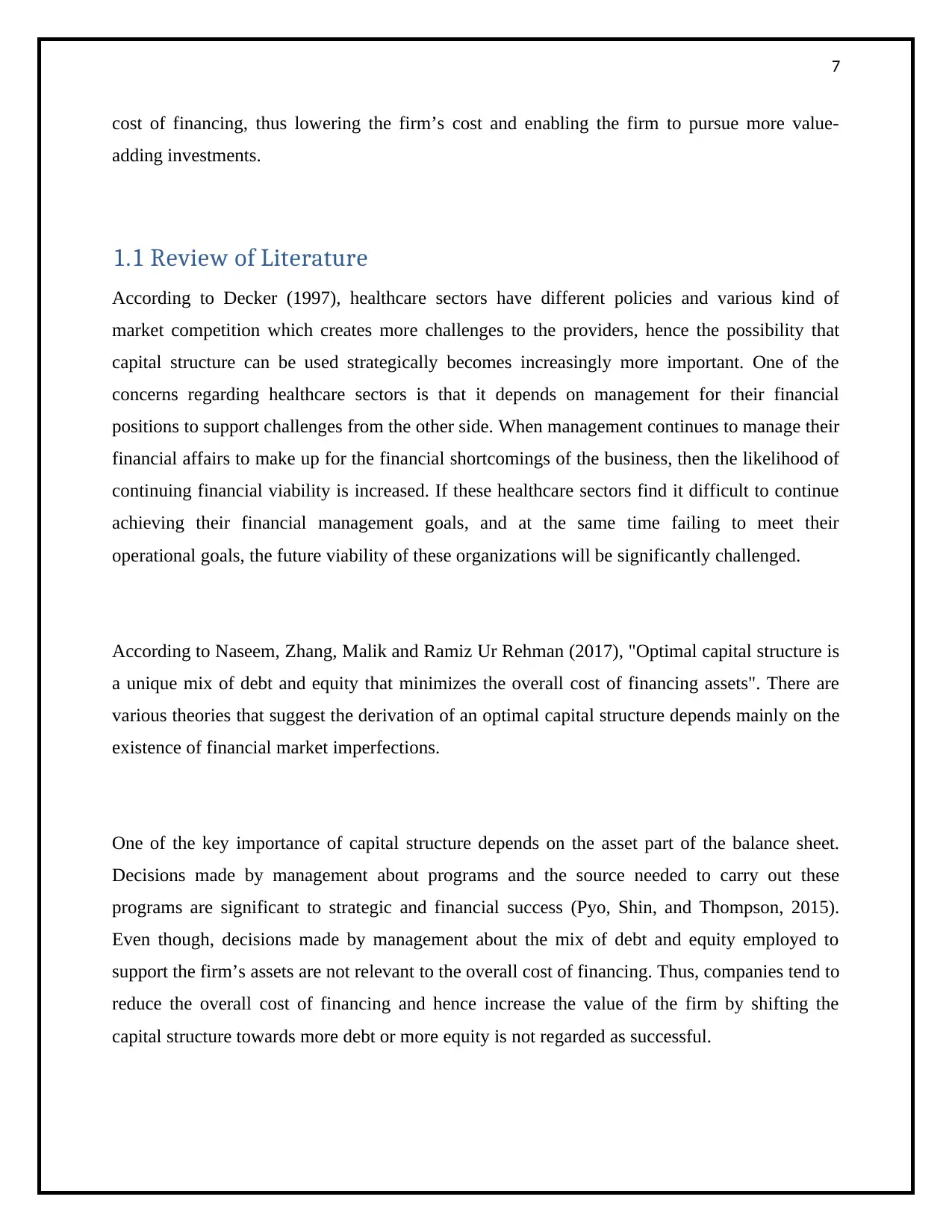
7
cost of financing, thus lowering the firm’s cost and enabling the firm to pursue more value-
adding investments.
1.1 Review of Literature
According to Decker (1997), healthcare sectors have different policies and various kind of
market competition which creates more challenges to the providers, hence the possibility that
capital structure can be used strategically becomes increasingly more important. One of the
concerns regarding healthcare sectors is that it depends on management for their financial
positions to support challenges from the other side. When management continues to manage their
financial affairs to make up for the financial shortcomings of the business, then the likelihood of
continuing financial viability is increased. If these healthcare sectors find it difficult to continue
achieving their financial management goals, and at the same time failing to meet their
operational goals, the future viability of these organizations will be significantly challenged.
According to Naseem, Zhang, Malik and Ramiz Ur Rehman (2017), "Optimal capital structure is
a unique mix of debt and equity that minimizes the overall cost of financing assets". There are
various theories that suggest the derivation of an optimal capital structure depends mainly on the
existence of financial market imperfections.
One of the key importance of capital structure depends on the asset part of the balance sheet.
Decisions made by management about programs and the source needed to carry out these
programs are significant to strategic and financial success (Pyo, Shin, and Thompson, 2015).
Even though, decisions made by management about the mix of debt and equity employed to
support the firm’s assets are not relevant to the overall cost of financing. Thus, companies tend to
reduce the overall cost of financing and hence increase the value of the firm by shifting the
capital structure towards more debt or more equity is not regarded as successful.
cost of financing, thus lowering the firm’s cost and enabling the firm to pursue more value-
adding investments.
1.1 Review of Literature
According to Decker (1997), healthcare sectors have different policies and various kind of
market competition which creates more challenges to the providers, hence the possibility that
capital structure can be used strategically becomes increasingly more important. One of the
concerns regarding healthcare sectors is that it depends on management for their financial
positions to support challenges from the other side. When management continues to manage their
financial affairs to make up for the financial shortcomings of the business, then the likelihood of
continuing financial viability is increased. If these healthcare sectors find it difficult to continue
achieving their financial management goals, and at the same time failing to meet their
operational goals, the future viability of these organizations will be significantly challenged.
According to Naseem, Zhang, Malik and Ramiz Ur Rehman (2017), "Optimal capital structure is
a unique mix of debt and equity that minimizes the overall cost of financing assets". There are
various theories that suggest the derivation of an optimal capital structure depends mainly on the
existence of financial market imperfections.
One of the key importance of capital structure depends on the asset part of the balance sheet.
Decisions made by management about programs and the source needed to carry out these
programs are significant to strategic and financial success (Pyo, Shin, and Thompson, 2015).
Even though, decisions made by management about the mix of debt and equity employed to
support the firm’s assets are not relevant to the overall cost of financing. Thus, companies tend to
reduce the overall cost of financing and hence increase the value of the firm by shifting the
capital structure towards more debt or more equity is not regarded as successful.
Paraphrase This Document
Need a fresh take? Get an instant paraphrase of this document with our AI Paraphraser
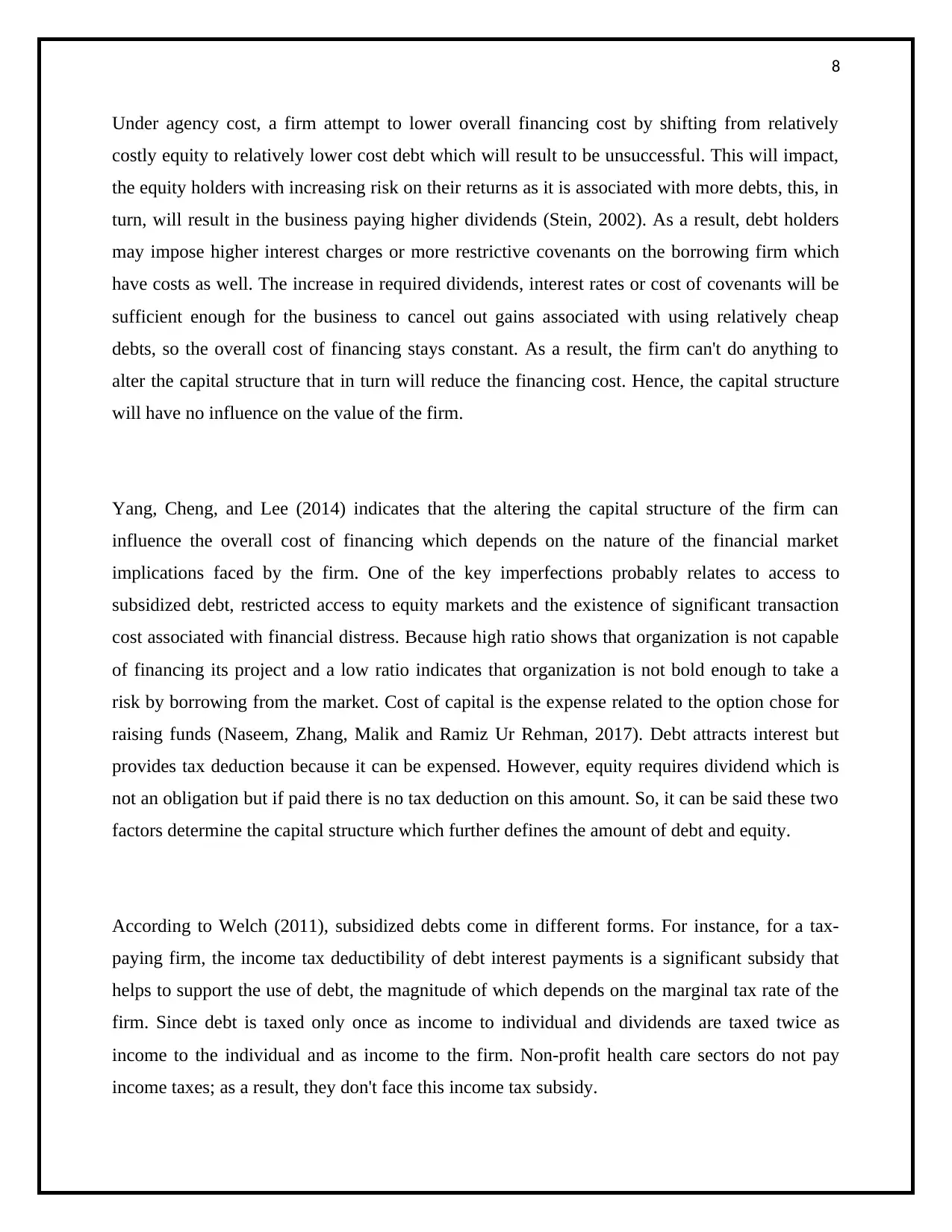
8
Under agency cost, a firm attempt to lower overall financing cost by shifting from relatively
costly equity to relatively lower cost debt which will result to be unsuccessful. This will impact,
the equity holders with increasing risk on their returns as it is associated with more debts, this, in
turn, will result in the business paying higher dividends (Stein, 2002). As a result, debt holders
may impose higher interest charges or more restrictive covenants on the borrowing firm which
have costs as well. The increase in required dividends, interest rates or cost of covenants will be
sufficient enough for the business to cancel out gains associated with using relatively cheap
debts, so the overall cost of financing stays constant. As a result, the firm can't do anything to
alter the capital structure that in turn will reduce the financing cost. Hence, the capital structure
will have no influence on the value of the firm.
Yang, Cheng, and Lee (2014) indicates that the altering the capital structure of the firm can
influence the overall cost of financing which depends on the nature of the financial market
implications faced by the firm. One of the key imperfections probably relates to access to
subsidized debt, restricted access to equity markets and the existence of significant transaction
cost associated with financial distress. Because high ratio shows that organization is not capable
of financing its project and a low ratio indicates that organization is not bold enough to take a
risk by borrowing from the market. Cost of capital is the expense related to the option chose for
raising funds (Naseem, Zhang, Malik and Ramiz Ur Rehman, 2017). Debt attracts interest but
provides tax deduction because it can be expensed. However, equity requires dividend which is
not an obligation but if paid there is no tax deduction on this amount. So, it can be said these two
factors determine the capital structure which further defines the amount of debt and equity.
According to Welch (2011), subsidized debts come in different forms. For instance, for a tax-
paying firm, the income tax deductibility of debt interest payments is a significant subsidy that
helps to support the use of debt, the magnitude of which depends on the marginal tax rate of the
firm. Since debt is taxed only once as income to individual and dividends are taxed twice as
income to the individual and as income to the firm. Non-profit health care sectors do not pay
income taxes; as a result, they don't face this income tax subsidy.
Under agency cost, a firm attempt to lower overall financing cost by shifting from relatively
costly equity to relatively lower cost debt which will result to be unsuccessful. This will impact,
the equity holders with increasing risk on their returns as it is associated with more debts, this, in
turn, will result in the business paying higher dividends (Stein, 2002). As a result, debt holders
may impose higher interest charges or more restrictive covenants on the borrowing firm which
have costs as well. The increase in required dividends, interest rates or cost of covenants will be
sufficient enough for the business to cancel out gains associated with using relatively cheap
debts, so the overall cost of financing stays constant. As a result, the firm can't do anything to
alter the capital structure that in turn will reduce the financing cost. Hence, the capital structure
will have no influence on the value of the firm.
Yang, Cheng, and Lee (2014) indicates that the altering the capital structure of the firm can
influence the overall cost of financing which depends on the nature of the financial market
implications faced by the firm. One of the key imperfections probably relates to access to
subsidized debt, restricted access to equity markets and the existence of significant transaction
cost associated with financial distress. Because high ratio shows that organization is not capable
of financing its project and a low ratio indicates that organization is not bold enough to take a
risk by borrowing from the market. Cost of capital is the expense related to the option chose for
raising funds (Naseem, Zhang, Malik and Ramiz Ur Rehman, 2017). Debt attracts interest but
provides tax deduction because it can be expensed. However, equity requires dividend which is
not an obligation but if paid there is no tax deduction on this amount. So, it can be said these two
factors determine the capital structure which further defines the amount of debt and equity.
According to Welch (2011), subsidized debts come in different forms. For instance, for a tax-
paying firm, the income tax deductibility of debt interest payments is a significant subsidy that
helps to support the use of debt, the magnitude of which depends on the marginal tax rate of the
firm. Since debt is taxed only once as income to individual and dividends are taxed twice as
income to the individual and as income to the firm. Non-profit health care sectors do not pay
income taxes; as a result, they don't face this income tax subsidy.
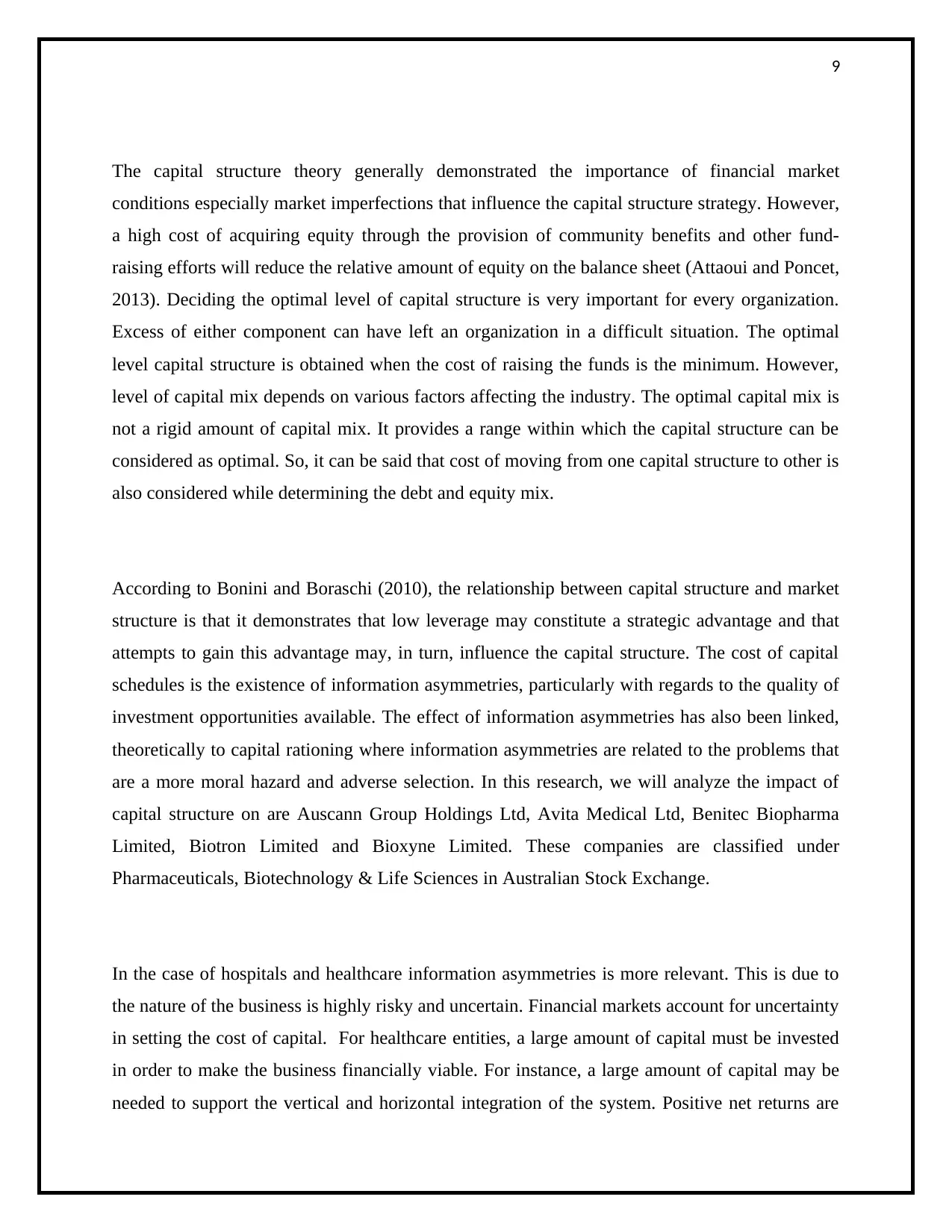
9
The capital structure theory generally demonstrated the importance of financial market
conditions especially market imperfections that influence the capital structure strategy. However,
a high cost of acquiring equity through the provision of community benefits and other fund-
raising efforts will reduce the relative amount of equity on the balance sheet (Attaoui and Poncet,
2013). Deciding the optimal level of capital structure is very important for every organization.
Excess of either component can have left an organization in a difficult situation. The optimal
level capital structure is obtained when the cost of raising the funds is the minimum. However,
level of capital mix depends on various factors affecting the industry. The optimal capital mix is
not a rigid amount of capital mix. It provides a range within which the capital structure can be
considered as optimal. So, it can be said that cost of moving from one capital structure to other is
also considered while determining the debt and equity mix.
According to Bonini and Boraschi (2010), the relationship between capital structure and market
structure is that it demonstrates that low leverage may constitute a strategic advantage and that
attempts to gain this advantage may, in turn, influence the capital structure. The cost of capital
schedules is the existence of information asymmetries, particularly with regards to the quality of
investment opportunities available. The effect of information asymmetries has also been linked,
theoretically to capital rationing where information asymmetries are related to the problems that
are a more moral hazard and adverse selection. In this research, we will analyze the impact of
capital structure on are Auscann Group Holdings Ltd, Avita Medical Ltd, Benitec Biopharma
Limited, Biotron Limited and Bioxyne Limited. These companies are classified under
Pharmaceuticals, Biotechnology & Life Sciences in Australian Stock Exchange.
In the case of hospitals and healthcare information asymmetries is more relevant. This is due to
the nature of the business is highly risky and uncertain. Financial markets account for uncertainty
in setting the cost of capital. For healthcare entities, a large amount of capital must be invested
in order to make the business financially viable. For instance, a large amount of capital may be
needed to support the vertical and horizontal integration of the system. Positive net returns are
The capital structure theory generally demonstrated the importance of financial market
conditions especially market imperfections that influence the capital structure strategy. However,
a high cost of acquiring equity through the provision of community benefits and other fund-
raising efforts will reduce the relative amount of equity on the balance sheet (Attaoui and Poncet,
2013). Deciding the optimal level of capital structure is very important for every organization.
Excess of either component can have left an organization in a difficult situation. The optimal
level capital structure is obtained when the cost of raising the funds is the minimum. However,
level of capital mix depends on various factors affecting the industry. The optimal capital mix is
not a rigid amount of capital mix. It provides a range within which the capital structure can be
considered as optimal. So, it can be said that cost of moving from one capital structure to other is
also considered while determining the debt and equity mix.
According to Bonini and Boraschi (2010), the relationship between capital structure and market
structure is that it demonstrates that low leverage may constitute a strategic advantage and that
attempts to gain this advantage may, in turn, influence the capital structure. The cost of capital
schedules is the existence of information asymmetries, particularly with regards to the quality of
investment opportunities available. The effect of information asymmetries has also been linked,
theoretically to capital rationing where information asymmetries are related to the problems that
are a more moral hazard and adverse selection. In this research, we will analyze the impact of
capital structure on are Auscann Group Holdings Ltd, Avita Medical Ltd, Benitec Biopharma
Limited, Biotron Limited and Bioxyne Limited. These companies are classified under
Pharmaceuticals, Biotechnology & Life Sciences in Australian Stock Exchange.
In the case of hospitals and healthcare information asymmetries is more relevant. This is due to
the nature of the business is highly risky and uncertain. Financial markets account for uncertainty
in setting the cost of capital. For healthcare entities, a large amount of capital must be invested
in order to make the business financially viable. For instance, a large amount of capital may be
needed to support the vertical and horizontal integration of the system. Positive net returns are
⊘ This is a preview!⊘
Do you want full access?
Subscribe today to unlock all pages.

Trusted by 1+ million students worldwide
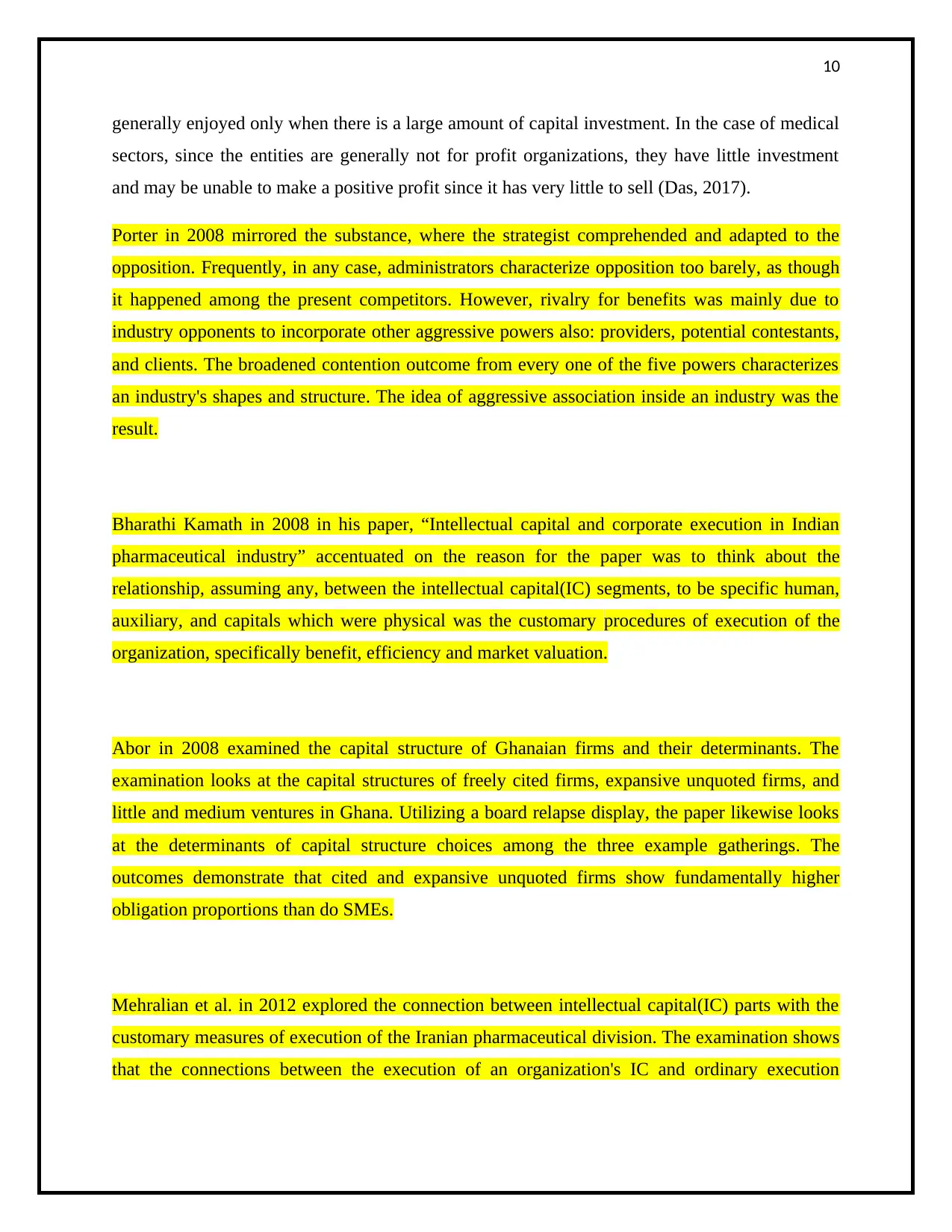
10
generally enjoyed only when there is a large amount of capital investment. In the case of medical
sectors, since the entities are generally not for profit organizations, they have little investment
and may be unable to make a positive profit since it has very little to sell (Das, 2017).
Porter in 2008 mirrored the substance, where the strategist comprehended and adapted to the
opposition. Frequently, in any case, administrators characterize opposition too barely, as though
it happened among the present competitors. However, rivalry for benefits was mainly due to
industry opponents to incorporate other aggressive powers also: providers, potential contestants,
and clients. The broadened contention outcome from every one of the five powers characterizes
an industry's shapes and structure. The idea of aggressive association inside an industry was the
result.
Bharathi Kamath in 2008 in his paper, “Intellectual capital and corporate execution in Indian
pharmaceutical industry” accentuated on the reason for the paper was to think about the
relationship, assuming any, between the intellectual capital(IC) segments, to be specific human,
auxiliary, and capitals which were physical was the customary procedures of execution of the
organization, specifically benefit, efficiency and market valuation.
Abor in 2008 examined the capital structure of Ghanaian firms and their determinants. The
examination looks at the capital structures of freely cited firms, expansive unquoted firms, and
little and medium ventures in Ghana. Utilizing a board relapse display, the paper likewise looks
at the determinants of capital structure choices among the three example gatherings. The
outcomes demonstrate that cited and expansive unquoted firms show fundamentally higher
obligation proportions than do SMEs.
Mehralian et al. in 2012 explored the connection between intellectual capital(IC) parts with the
customary measures of execution of the Iranian pharmaceutical division. The examination shows
that the connections between the execution of an organization's IC and ordinary execution
generally enjoyed only when there is a large amount of capital investment. In the case of medical
sectors, since the entities are generally not for profit organizations, they have little investment
and may be unable to make a positive profit since it has very little to sell (Das, 2017).
Porter in 2008 mirrored the substance, where the strategist comprehended and adapted to the
opposition. Frequently, in any case, administrators characterize opposition too barely, as though
it happened among the present competitors. However, rivalry for benefits was mainly due to
industry opponents to incorporate other aggressive powers also: providers, potential contestants,
and clients. The broadened contention outcome from every one of the five powers characterizes
an industry's shapes and structure. The idea of aggressive association inside an industry was the
result.
Bharathi Kamath in 2008 in his paper, “Intellectual capital and corporate execution in Indian
pharmaceutical industry” accentuated on the reason for the paper was to think about the
relationship, assuming any, between the intellectual capital(IC) segments, to be specific human,
auxiliary, and capitals which were physical was the customary procedures of execution of the
organization, specifically benefit, efficiency and market valuation.
Abor in 2008 examined the capital structure of Ghanaian firms and their determinants. The
examination looks at the capital structures of freely cited firms, expansive unquoted firms, and
little and medium ventures in Ghana. Utilizing a board relapse display, the paper likewise looks
at the determinants of capital structure choices among the three example gatherings. The
outcomes demonstrate that cited and expansive unquoted firms show fundamentally higher
obligation proportions than do SMEs.
Mehralian et al. in 2012 explored the connection between intellectual capital(IC) parts with the
customary measures of execution of the Iranian pharmaceutical division. The examination shows
that the connections between the execution of an organization's IC and ordinary execution
Paraphrase This Document
Need a fresh take? Get an instant paraphrase of this document with our AI Paraphraser
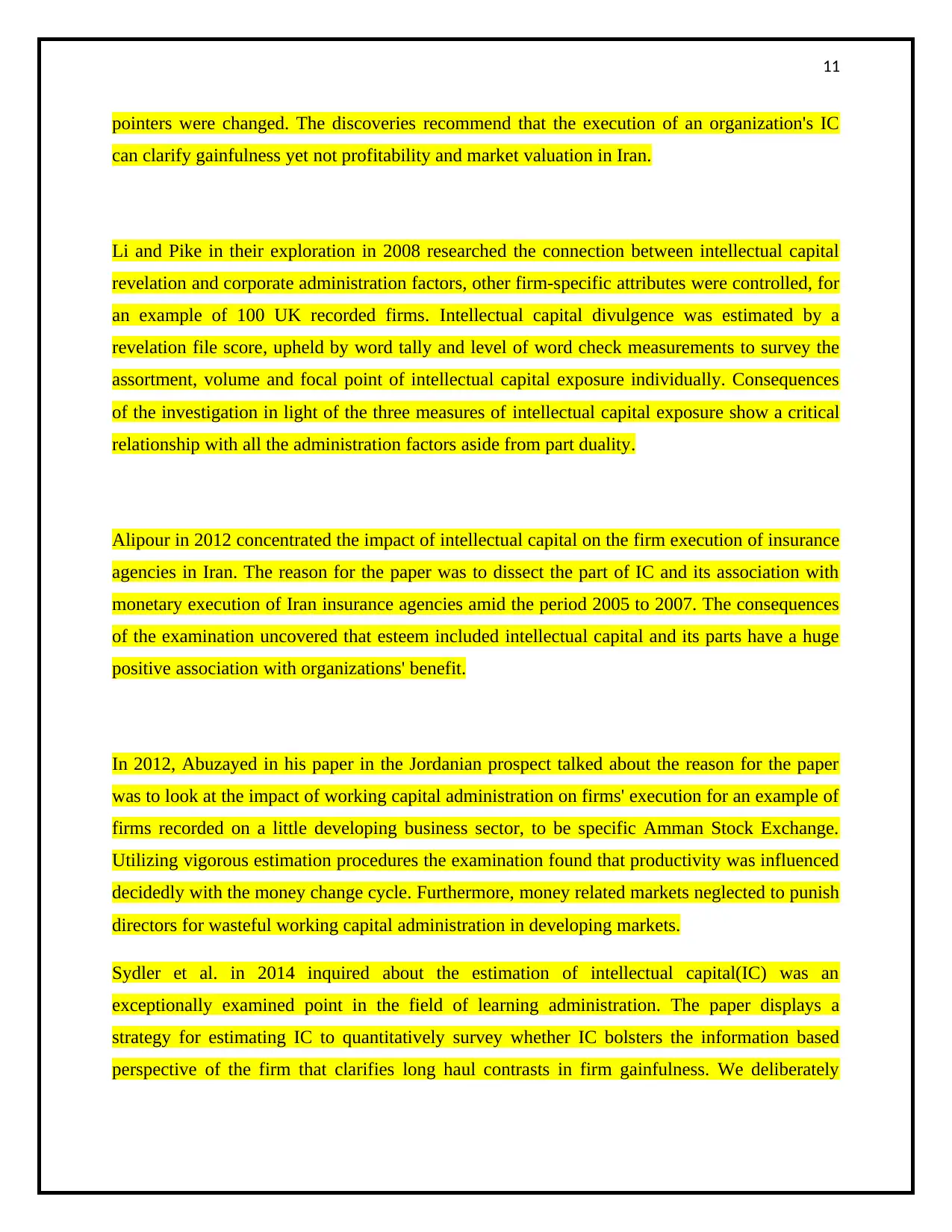
11
pointers were changed. The discoveries recommend that the execution of an organization's IC
can clarify gainfulness yet not profitability and market valuation in Iran.
Li and Pike in their exploration in 2008 researched the connection between intellectual capital
revelation and corporate administration factors, other firm‐specific attributes were controlled, for
an example of 100 UK recorded firms. Intellectual capital divulgence was estimated by a
revelation file score, upheld by word tally and level of word check measurements to survey the
assortment, volume and focal point of intellectual capital exposure individually. Consequences
of the investigation in light of the three measures of intellectual capital exposure show a critical
relationship with all the administration factors aside from part duality.
Alipour in 2012 concentrated the impact of intellectual capital on the firm execution of insurance
agencies in Iran. The reason for the paper was to dissect the part of IC and its association with
monetary execution of Iran insurance agencies amid the period 2005 to 2007. The consequences
of the examination uncovered that esteem included intellectual capital and its parts have a huge
positive association with organizations' benefit.
In 2012, Abuzayed in his paper in the Jordanian prospect talked about the reason for the paper
was to look at the impact of working capital administration on firms' execution for an example of
firms recorded on a little developing business sector, to be specific Amman Stock Exchange.
Utilizing vigorous estimation procedures the examination found that productivity was influenced
decidedly with the money change cycle. Furthermore, money related markets neglected to punish
directors for wasteful working capital administration in developing markets.
Sydler et al. in 2014 inquired about the estimation of intellectual capital(IC) was an
exceptionally examined point in the field of learning administration. The paper displays a
strategy for estimating IC to quantitatively survey whether IC bolsters the information based
perspective of the firm that clarifies long haul contrasts in firm gainfulness. We deliberately
pointers were changed. The discoveries recommend that the execution of an organization's IC
can clarify gainfulness yet not profitability and market valuation in Iran.
Li and Pike in their exploration in 2008 researched the connection between intellectual capital
revelation and corporate administration factors, other firm‐specific attributes were controlled, for
an example of 100 UK recorded firms. Intellectual capital divulgence was estimated by a
revelation file score, upheld by word tally and level of word check measurements to survey the
assortment, volume and focal point of intellectual capital exposure individually. Consequences
of the investigation in light of the three measures of intellectual capital exposure show a critical
relationship with all the administration factors aside from part duality.
Alipour in 2012 concentrated the impact of intellectual capital on the firm execution of insurance
agencies in Iran. The reason for the paper was to dissect the part of IC and its association with
monetary execution of Iran insurance agencies amid the period 2005 to 2007. The consequences
of the examination uncovered that esteem included intellectual capital and its parts have a huge
positive association with organizations' benefit.
In 2012, Abuzayed in his paper in the Jordanian prospect talked about the reason for the paper
was to look at the impact of working capital administration on firms' execution for an example of
firms recorded on a little developing business sector, to be specific Amman Stock Exchange.
Utilizing vigorous estimation procedures the examination found that productivity was influenced
decidedly with the money change cycle. Furthermore, money related markets neglected to punish
directors for wasteful working capital administration in developing markets.
Sydler et al. in 2014 inquired about the estimation of intellectual capital(IC) was an
exceptionally examined point in the field of learning administration. The paper displays a
strategy for estimating IC to quantitatively survey whether IC bolsters the information based
perspective of the firm that clarifies long haul contrasts in firm gainfulness. We deliberately
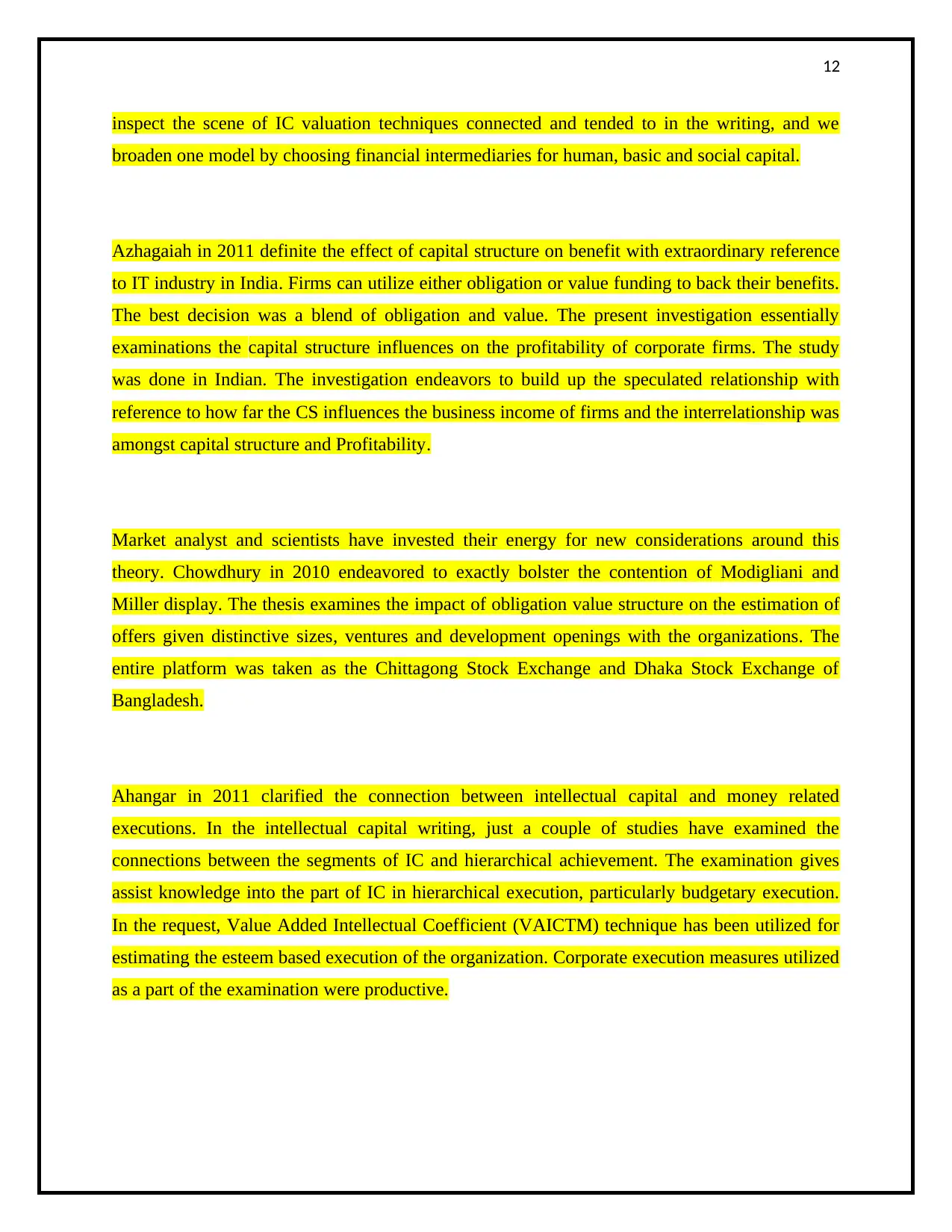
12
inspect the scene of IC valuation techniques connected and tended to in the writing, and we
broaden one model by choosing financial intermediaries for human, basic and social capital.
Azhagaiah in 2011 definite the effect of capital structure on benefit with extraordinary reference
to IT industry in India. Firms can utilize either obligation or value funding to back their benefits.
The best decision was a blend of obligation and value. The present investigation essentially
examinations the capital structure influences on the profitability of corporate firms. The study
was done in Indian. The investigation endeavors to build up the speculated relationship with
reference to how far the CS influences the business income of firms and the interrelationship was
amongst capital structure and Profitability.
Market analyst and scientists have invested their energy for new considerations around this
theory. Chowdhury in 2010 endeavored to exactly bolster the contention of Modigliani and
Miller display. The thesis examines the impact of obligation value structure on the estimation of
offers given distinctive sizes, ventures and development openings with the organizations. The
entire platform was taken as the Chittagong Stock Exchange and Dhaka Stock Exchange of
Bangladesh.
Ahangar in 2011 clarified the connection between intellectual capital and money related
executions. In the intellectual capital writing, just a couple of studies have examined the
connections between the segments of IC and hierarchical achievement. The examination gives
assist knowledge into the part of IC in hierarchical execution, particularly budgetary execution.
In the request, Value Added Intellectual Coefficient (VAICTM) technique has been utilized for
estimating the esteem based execution of the organization. Corporate execution measures utilized
as a part of the examination were productive.
inspect the scene of IC valuation techniques connected and tended to in the writing, and we
broaden one model by choosing financial intermediaries for human, basic and social capital.
Azhagaiah in 2011 definite the effect of capital structure on benefit with extraordinary reference
to IT industry in India. Firms can utilize either obligation or value funding to back their benefits.
The best decision was a blend of obligation and value. The present investigation essentially
examinations the capital structure influences on the profitability of corporate firms. The study
was done in Indian. The investigation endeavors to build up the speculated relationship with
reference to how far the CS influences the business income of firms and the interrelationship was
amongst capital structure and Profitability.
Market analyst and scientists have invested their energy for new considerations around this
theory. Chowdhury in 2010 endeavored to exactly bolster the contention of Modigliani and
Miller display. The thesis examines the impact of obligation value structure on the estimation of
offers given distinctive sizes, ventures and development openings with the organizations. The
entire platform was taken as the Chittagong Stock Exchange and Dhaka Stock Exchange of
Bangladesh.
Ahangar in 2011 clarified the connection between intellectual capital and money related
executions. In the intellectual capital writing, just a couple of studies have examined the
connections between the segments of IC and hierarchical achievement. The examination gives
assist knowledge into the part of IC in hierarchical execution, particularly budgetary execution.
In the request, Value Added Intellectual Coefficient (VAICTM) technique has been utilized for
estimating the esteem based execution of the organization. Corporate execution measures utilized
as a part of the examination were productive.
⊘ This is a preview!⊘
Do you want full access?
Subscribe today to unlock all pages.

Trusted by 1+ million students worldwide
1 out of 103
Related Documents
Your All-in-One AI-Powered Toolkit for Academic Success.
+13062052269
info@desklib.com
Available 24*7 on WhatsApp / Email
![[object Object]](/_next/static/media/star-bottom.7253800d.svg)
Unlock your academic potential
Copyright © 2020–2025 A2Z Services. All Rights Reserved. Developed and managed by ZUCOL.





